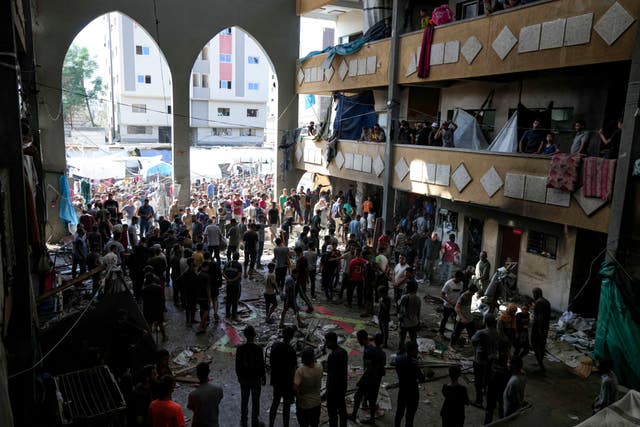Israeli airstrikes kill at least 22 people in refugee camp in northern Gaza
People are being urged to head south to Muwasi, a packed area in southern Gaza designated by the military as a humanitarian zone.

Israeli airstrikes flattened a residential area and killed at least 22 people including women and children in an urban refugee camp in northern Gaza, Palestinian medical officials said on Saturday.
In an area where Israel’s military launched a major ground operation last week, one of the strikes late on Friday destroyed an entire building, killing at least 20 people and severely damaging several nearby buildings in the centre of Jabaliya camp, according to the health ministry’s ambulance and emergency service.
A different strike killed a mother, father and injured their baby in another part of Jabaliya, the refugee camp where Israeli forces carried out several major operations over the course of the war, medical officials said.

At least 20 bodies had been recovered from the area as of Saturday morning, with many others said to be missing under the rubble, emergency service officials said, adding that at least six women and seven children were killed.
Gaza’s health ministry on Saturday said hospitals across Gaza received the bodies of 49 people killed over the past 24 hours. Hospitals also received 219 wounded. The deaths brought the death tally to 42,175 since the war began on October 7 last year, with 98,339 wounded, according to the ministry.
Israeli military officials did not immediately respond to a request for comment.
The figures came as the Israeli military renewed its orders for Palestinian in the northern Gaza Strip to leave their homes and shelters as troops continue an offensive against militants.
Military spokesman Avichay Adraee told people to leave parts of Gaza City’s Sheikh Radwan area and other locations in and around Jabaliya.
In a post on X, formerly Twitter, Mr Adraee asked people to head south to Muwasi, a packed area in southern Gaza designated by the military as a humanitarian zone.
Most of the fighting in the past week was centred in and around Jabaliya that was pounded by Israeli war jets and artillery.
Residents said they have been trapped inside their homes and shelters.
The military also ordered the three main hospitals in northern Gaza to evacuate patients and medical staff.
Hunger warnings emerged again as residents in northern Gaza said they had not received aid since the beginning of the month. The UN World Food Programme said no food aid had entered the north since October 1. An estimated 400,000 people remain there.

The shooting occurred a day after Israel’s military fired on the headquarters for the second straight day. Israel, which has warned the peacekeepers to leave their positions, did not immediately respond to questions.
Lebanese authorities said Friday that 60 people were killed and 168 wounded in the past 24 hours. The total toll in Lebanon over the past year of conflict between Israel and Hezbollah is now 2,255 killed, according to the Lebanese health ministry.
Israel has been escalating its campaign against Hezbollah with waves of heavy air strikes across Lebanon and a ground invasion at the border, after a year of exchanges of fire.
Israel’s military said that Hezbollah fired more than 300 projectiles over the Yom Kippur holiday. The military said that it killed 50 militants in Lebanon. Claims on either side could not be verified.
“We will keep standing with the Lebanese people during these difficult circumstances and also with the Palestinian people,” the speaker of Iran’s parliament, Mohammad Bagher Qalibaf, said on Saturday while touring the scene of an Israeli airstrike in Beirut.
Israel is now at war with Hamas in Gaza and Hamas’ ally Hezbollah in Lebanon.
Israel’s offensive in Gaza has killed more than 42,000 Palestinians, according to local health authorities, who do not say how many were fighters but say women and children make up more than half of the fatalities.
The war has destroyed large areas of Gaza and displaced about 90% of its population of 2.3 million people, often multiple times.
It has been a full year since Hamas-led militants blew holes in Israel’s security fence and stormed into army bases and farming communities, killing some 1,200 people, mostly civilians, and abducting another 250.
They are still holding about 100 captives inside Gaza, a third of whom are believed to be dead.
Later on Saturday, US official said the Biden administration is considering sending one of its Terminal High Altitude Area Defense (THAAD) systems to Israel. A defence official said no final decision has been made.
A US official said there were ongoing discussions late last week about deploying a THAAD to Israel. Both officials spoke on condition of anonymity to discuss internal deliberations.
The US has a wide range of missile defence systems across the Middle East and Europe, including Patriot systems. Officials have been discussing for months what types of air defence systems to deploy to the region and where to put them.
Any move of a THAAD to Israel would involve the deployment of soldiers to operate the complex system.
A year ago, US defence secretary Lloyd Austin ordered the deployment of a THAAD battery and additional Patriot battalions to locations around the Middle East to increase protection of US forces and to aid in the defence of Israel.
According to an April report by the Congressional Research Service, the US army has seven THAAD batteries. Generally each consists of six truck-mounted launchers, 48 interceptors, radio and radar equipment and it requires 95 soldiers to operate.
The THAAD is considered a complimentary system to the Patriot, but it can defend a wider area. It can hit targets at ranges of 150-200km (93-124 miles).





